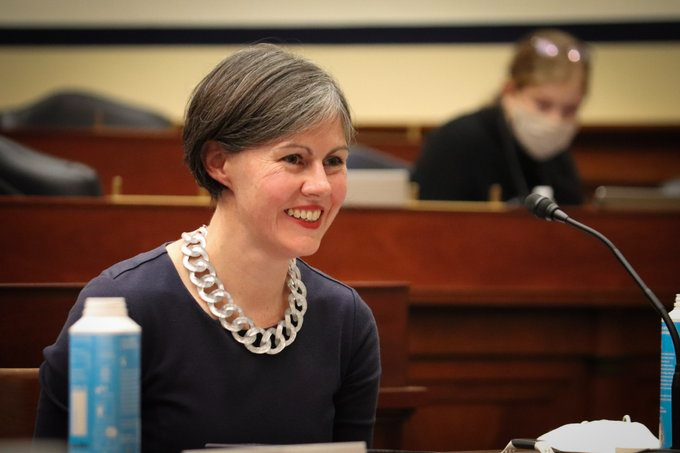Remaking government to meet the moment

Matt Anderson Photography/Getty Images
Tara Dawson McGuinness, a Healthcare.gov alum and founder of New America’s New Practice Lab, talked to FCW about public interest technology and customer experience.
Tara Dawson McGuinness is hopeful about the future of government service delivery.
"The pandemic created an opening for people to see there's no solving our hardest problems without governments that can decide and deliver," she says.
While there's hope, there's also work. Right now, there are "healthcare.gov's everywhere waiting because of the aging of the technology and the thinly staffed public sector," said McGuinness.
McGuinness is Obama White House alum who worked on organizing and communications for Healthcare.gov and in the Office of Management and Budget for federal initiatives to support cities and towns.

She's also co-author of the book "Power to the Public" and founder of the New Practice Lab, a research and design lab, at think tank New America. Recently, she led the domestic policy team for the Biden transition.
She talked with FCW about her work and the work of the current administration to improve how the government delivers services to Americans. The following interview has been lightly edited for clarity and length.
Your book centers around public interest technology - what is that? And how does the tech part fit in?
Public interest technology is not a technology. It's a practice in service of the public good… We define it as the application of data, design and delivery to advance public interest and promote public good in the digital age.
Solving the world's hardest problems will not rely on a technology alone. It is always a combination of understanding the real problem, a management process, the humans who are using the new technology.
I think in particular for government leaders, there are a lot of people knocking on their door saying, 'I have an X, Y and Z that will solve your problem and make your thing move faster and help you with your procurements.'
We see different sets of technologies and practices that have been used in the tech industry as really important to having governments that serve the public in a modern way, but a component part… The first step is never the technology. It's asking, 'What is the root cause? What is the root problem? Who are the people using this?'
Customer experience is getting a spotlight because of a recent executive order. How is that a part of public interest tech?
We really break [public interest technology] down into these three parts. One is designing for the humans you're serving. The second is using data. And the third is having a practice of testing.
Customer experience really largely lives in that first part of design. Did you think of 'Who is your customer for this tax form?'
So customer experience as a kind of proxy for connecting a policy to the intended audience of a policy is incredibly important, and notionally is a part of all policymaking.
But as a practical matter, we've really advanced our economic analysis tools over the past 30 years … [but] when a bill is moving through Congress, no one is assessing the same types of things we're doing on kind of a cost-benefit space for the ease for consumers.
So really giving directions inside the federal government, or a government agency at any level, to weight as heavily as you weight fraud prevention or speed or legal frameworks is, are we weighting and pointing and valuing and creating performance indicators for the consumer experience, because isn't that what government is fundamentally about?
You mentioned the role of Congress here. Could you talk more about that?
I teach this course at Georgetown to public policy grad students… Every year, I stump my graduate students, who are leading in climate work or food security, by asking them in their first assignment to bring a form.
This training is just missing from how we learn to be policy experts. The further you rise in the policy architecture, the farther you get away from a frontline facing experience, and so we need at all levels to be training policy leaders to think about the full chain.
Let me give a concrete example. When the first stimulus package was passed, there was a check cut notably for all Americans who needed cash. It really was not in the sight initially of the administration at the time, in Congress, that the people who need that check the most are not taxpayers, so we just have no way to send them the check. That's a very clear gap - that's I believe 10 million people out of the gate.
The world has changed, and we need to upgrade our institutions to meet that moment.
There are not that many companies that were around at the turn of the century. [There's been] a dramatic shift in who the leading companies are. There is not the flexibility to have government agencies replaced by a new startup, so we need to do the reform from inside and that is much harder than starting fresh.
What tools does the government need to undergo this change?
The federal government has grown the pool of talent and agencies and teams and tools … enormously since Healthcare.gov. That's inclusive of the U.S. Digital Services, of 18F, of new roles inside agencies that are consumer experience roles at agencies.
The growth of new roles …is phenomenal. It's not yet sufficient to meet the challenge of our time. I think version 1.0 is new roles and teams.
Version 2.0 is the meshing of traditional structures on budgeting, policymaking with these new teams on implementation and moving more and more upstream the thinking about how a policy will reach an individual or family, so that it's not an afterthought.
The importance of moving these skills and growing them at the state level is also the next frontier… The real, front-facing federal front door is often a state agency, so making sure that this type of data and delivery, talent recruitment capacity, skillset, flexibility and hiring authorities is happening at a state level when you've seen massive public sector cuts to me is the next priority.
Let's talk about Healthcare.gov. How did it inform how you think about all of these issues?
Healthcare.gov was more than a technology problem. There were technology problems, but part of it was a focus on decision-making processes.
I think there are Healthcare.govs everywhere waiting because of the aging of the technology and the thinly staffed public sector. Whether it's at the IRS or Social Security, we have squeezed teams to the breaking point.
Healthcare.gov, while cataclysmic out of the gate, is not an outlier of the type of problems that agency leaders wake up and face every day.
They all need this level of effort that we gave Healthcare.gov, which was ruthless prioritization, a policymaking process that was in a feedback loop with the public, and teams in the federal government and contractors that were working seamlessly with transparency about what was working and what was not working.
Any final thoughts about where we're headed?
The pandemic created an opening around the globe for people to see there's no solving our hardest problems without governments that can decide and deliver… The need to get vaccines – not just discovered, but in the arms of all people – [and] to get stimulus checks out quickly to every community has generated a conversation about government delivery in a way that is hopefully a silver lining.
This is an enormous opportunity that has come from real difficulty, and I couldn't be more hopeful about the moment we're in for improving permanently the way that government listens and serves the public.



